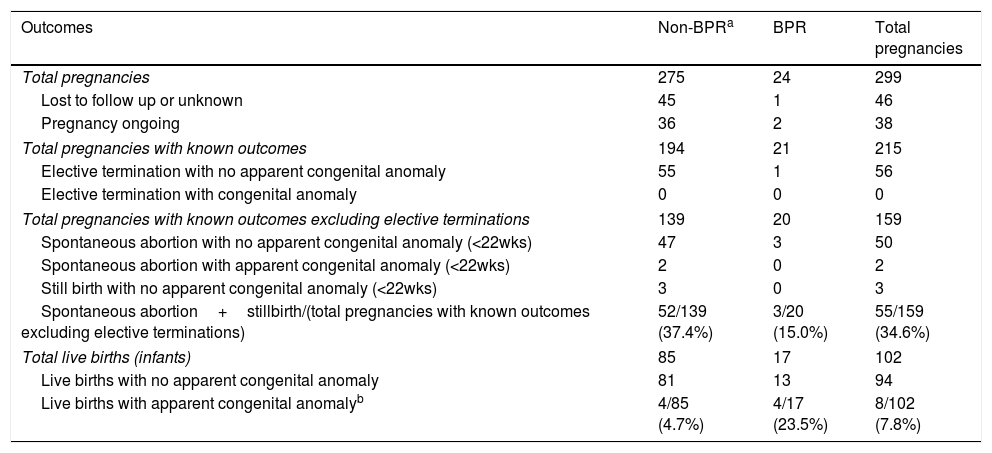Mister editor, belimumab is a fully human IgG1-λ monoclonal antibody that binds to soluble human B-cell survival factor (known as BLyS or BAFF) and inhibits its biological activity.1 Belimumab was approved for treatment of systemic lupus erythematosus (SLE) because it showed superiority to the standard of care, excluding patients with active nephritis or central nervous system disease.1,2 Here, we report a case of a SLE patient that was incidentally exposed to belimumab during the first trimester of pregnancy.
A 27-year-old Caucasian female with SLE has been followed for this disease for 10 years. She began with arthritis in her hands, malar rash, oral ulcers, and serositis. Her immunology laboratory had ANA 1/1280, homogenous nuclear pattern, positive anti-dsDNA, positive anti Ro and positive lupus anticoagulant, as well as low C3 and C4 complement levels. She followed treatments with corticosteroids, hydroxychloroquine and methotrexate, with a good initial response, but effectiveness decreased over time. She started to be refractory concerning serositis, arthritis, oral ulcers and skin abnormalities related to these medications, and never had lupus nephritis or neurological compromise. Treatment with belimumab began two years before pregnancy. During this time the disease was successfully controlled, with 0 SLEDAI (SLE Disease Activity Index) points and without adverse events.
She discontinued coming to medical controls; and during this time she got pregnant. When controls were resumed, at week twelve of pregnancy, belimumab was stopped. Her pregnancy was successful, with no SLE reactivation. At week 39.6, due to oligohydramnios and lack of adequate progression, she underwent a cesarean section without any complication. The weight of the newborn was 3520 grams.
This case was an accidental condition, where the patient did not follow her medical controls and never referred to a rheumatologist for pre-pregnancy counseling.
Belimumab was well tolerated at pharmacologically active dose levels in pregnant monkeys and their infants after exposure throughout pregnancy.3 No formal clinical studies have been conducted in pregnant women.4,5
The Belimumab Pregnancy Registry (BPR) aims to evaluate pregnancy and infant outcomes in women with SLE exposed to belimumab within the 4 months prior to and/or during pregnancy.6 Data of clinical trial outcomes, spontaneous pregnancy reports, and post-marketing surveillance reports outside of the BPR have reported a total of 275 pregnancies.7 Total outcomes, BPR and non-BPR, eight were live births with apparent congenital anomaly. Table 1 shows these outcomes.7 The congenital abnormalities reported in live infants of patients exposed to belimumab included Dandy Walker syndrome, bilateral enlarged kidneys, pulmonic stenosis, mild Ebstein anomaly, unbalanced translocation between chromosomes 11 and 13, bilateral club foot, and ventricular septal defect.8
Cumulative pregnancy outcomes for belimumab from clinical trials, spontaneous reports, post-marketing surveillance reports, and the Belimumab Pregnancy Registry (BPR) through 08 March 2016.7
| Outcomes | Non-BPRa | BPR | Total pregnancies |
|---|---|---|---|
| Total pregnancies | 275 | 24 | 299 |
| Lost to follow up or unknown | 45 | 1 | 46 |
| Pregnancy ongoing | 36 | 2 | 38 |
| Total pregnancies with known outcomes | 194 | 21 | 215 |
| Elective termination with no apparent congenital anomaly | 55 | 1 | 56 |
| Elective termination with congenital anomaly | 0 | 0 | 0 |
| Total pregnancies with known outcomes excluding elective terminations | 139 | 20 | 159 |
| Spontaneous abortion with no apparent congenital anomaly (<22wks) | 47 | 3 | 50 |
| Spontaneous abortion with apparent congenital anomaly (<22wks) | 2 | 0 | 2 |
| Still birth with no apparent congenital anomaly (<22wks) | 3 | 0 | 3 |
| Spontaneous abortion+stillbirth/(total pregnancies with known outcomes excluding elective terminations) | 52/139 (37.4%) | 3/20 (15.0%) | 55/159 (34.6%) |
| Total live births (infants) | 85 | 17 | 102 |
| Live births with no apparent congenital anomaly | 81 | 13 | 94 |
| Live births with apparent congenital anomalyb | 4/85 (4.7%) | 4/17 (23.5%) | 8/102 (7.8%) |
The EULAR points for use of belimumab before pregnancy, during pregnancy and lactation is that there is limited documentation and should be replaced before conception by other medication.9 The British Society for Rheumatology (BSR) and the British Health Professionals in Rheumatology (BHPR) guideline announces a similar statement, saying that there is insufficient data to recommend belimumab in pregnancy and an unintentional first trimester exposure is unlikely to be harmful.10
There is insufficient evidence to prove absolute safety for use belimumab during pregnancy. We need human clinical studies evaluating the use of belimumab in pregnant women to know the usefulness and safety of this drug. Over time, data from the BPR would be useful to assess safety of this agent for use in pregnancy SLE patients.5






